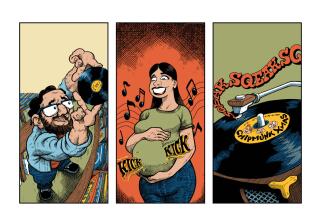DON’T JUDGE A CD BY ITS HINGED CASE
- Share via
Buy a CD and you never know what you’ll get.
Oh, sure, the compact discs are reliable enough--defective ones don’t seem common. And those hinged cases are uniform (even if they do break easily--fortunately, record stores are starting to carry empty $2 replacements). The unknown realm is the printed enclosure. From the outside of the cellophane-wrapped CD, you can’t tell whether you’ll open it up to find nothing more than a small reproduction of the album cover or a 10-page booklet with lyrics and liner notes.
The latter is what one gets, for example, with the CD original Broadway cast recording of Rupert Holmes’ “The Mystery of Edwin Drood.” Buy the original-cast CD of Stephen Sondheim’s “A Little Night Music,” however, and you don’t get the libretto that comes with the album.
Another example of lush packaging is the CD for “Kurt Weill: Lost in the Stars,” a marvelous collection featuring contemporary musicians’ versions of the German composer’s angular songs. Not only are the album’s generous liner notes included, but they’re revised and lengthened to provide information on the CD’s extra few minutes of music. Classical compact discs generally seem to contain the same information as the album, or more.
On the other hand, most pop CDs come with little or no printed material. In the jazz field, Miles Davis fans might expect their $15 for the CD version of “Kind of Blue” to also entitle them to jottings on the classic late-’50s recording session (which included John Coltrane, Cannonball Adderley and Bill Evans, among others) . . . but no-o-o-o-o. Even songwriter credits and timings, standard on even the most minimally packaged album, are not listed.
Import CDs, which often cost even more, can be disappointing on this count, too. For example, a compact disc of Nino Rota music compiled from two albums--both of which had extensive liner notes--comes with no liner notes.
Maybe the record companies think the customer is too overwhelmed by the CD’s digital sound and programming pluses to care about packaging or extras. Anyone want to let them know otherwise?
VIDEO BUILT-INS: Last year, Sony introduced a 25-inch TV with an 8-millimeter VCR built into it. Now other companies are planning to market similar models. At first, this combo might sound like a good idea. Why not get everything you need in one package?
But if you’re considering such a buy, think about this: What if something goes wrong with the VCR and you need it repaired? That would involve bringing the entire hefty combination into the repair shop.
On top of that, VCRs are shockingly expensive to fix and are quickly outmoded by models featuring such recent developments as hi-fi, SuperBeta and HQ circuits. Thus, many VCR owners buy a new model when the old one breaks down (and often before), making the TV-VCR combo sound like double trouble.
SPARS CODE: Home Tech compact-disc reviews running in this section on Tuesdays now note the disc’s Society of Professional Audio Recording Studios code, which notes whether the disc was derived from an analog or digital recording, along with an explanation of whether the CD is taken from an analog or a digital original recording.
The code consists of three letters, each either an A (for analog) or D (for digital). The first letter is the most important, indicating how the album was originally recorded. The second denotes how the album was mixed, the third how the CD was mastered (all CDs are digitally mastered).
The most common codes are AAD and DDD. AAD means that the original recording was recorded onto analog tape and therefore will have at least a little tape hiss, that it was mixed in the standard fashion with analog equipment and was then digitally transferred to the compact disc.
Sometimes you’ll see an ADD code, which means that there was a digital remix. Often, this extra care can greatly improve the sound of an old album, depending largely on how adept the mixing engineer was. DDD is the most preferred code in the minds of most CD connoisseurs--meaning that all recording, mixing and mastering were digital. On these discs the listener enjoys the sensation of being able to turn up the volume without hearing any tape hiss.
THE EYES HOUSE: “Footsies ‘86” is what the Ice House in Pasadena calls its adjoining dance club (a renovation of its old cabaret room), but it’s more like “Eyesies ’86.” Footsies not only shows rock videos but--taking a cue from computer dating services--offers a way for singles to meet via video.
Here’s how it works: For no extra charge, a patron can tape a 45- to 60-second video message on the premises, and the messages are flashed on the club’s TV monitors every 30 minutes. Every table in the place has a message pad, so if someone’s video has caught your interest, you just write a little mash note addressed to the number (no names at this stage) that appeared with the clip.
“People have different reactions to it,” says Elaine Tallas-Cardone, Ice House promotion and advertising director. “Some take it very seriously, others have fun with it and make humorous messages, others don’t care for it.” So far, more than 300 people have taken part.
But why is the place called Footsies? A publicity release notes that the club “is also known for its foot fetish (sic), a decor of assorted footwear designed to encourage you to try out your footwork under the table or on the dance floor,” plus Footsies is the “home of the world’s largest collection of celebrity shoes.”
More to Read
The biggest entertainment stories
Get our big stories about Hollywood, film, television, music, arts, culture and more right in your inbox as soon as they publish.
You may occasionally receive promotional content from the Los Angeles Times.










